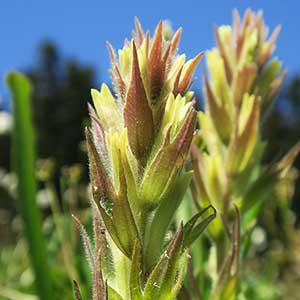Castilleja cryptantha
Castilleja citrina
Mt. Rainier or obscure paintbrush, obscure Indian paintbrush, obscure paintbrush
lemon paintbrush
few to several, erect or ascending, unbranched, hairs spreading, long, soft, eglandular, mixed with short stipitate-glandular ones.
few to many, erect to ascending, unbranched or branched, hairs appressed to ± ascending, matted, long, soft, mixed with short-glandular ones, denser distally, sometimes obscuring surface.
green, often with brown or purple veins, narrowly to broadly lanceolate, 1.5–4 cm, not fleshy, margins plane, ± involute, 0–3-lobed, apex acute to acuminate;
lobes spreading-ascending, narrowly lanceolate, apex acute to ± obtuse.
green, sometimes brown, linear to linear-lanceolate, 3–7 cm, not fleshy, margins plane, involute, 3–7-lobed, apex acute to rounded;
lateral lobes spreading, narrowly linear, apex acuminate.
(2.5–)3–6 × 1–2 cm; green to dull brown or dull reddish purple throughout, or proximally green to dull brown or dull reddish purple, distally yellow on apices, broadly lanceolate to ovate, (0–)3-lobed;
lobes ascending, narrowly lanceolate, long or short, arising near mid length, apex acute or acuminate.
(3.5–)8–20 × 2–5.5 cm;
bracts proximally greenish, distally bright yellow, sometimes pale yellow to pale orange, sometimes aging white to pink, narrowly to broadly lanceolate or oblong, 3–5(–7)-lobed;
lobes spreading to ascending, linear, long, arising at or below mid length, apex obtuse to rounded.
straight, 14–16 mm;
tube 11–14 mm;
whole corolla included within calyx;
beak adaxially pale yellow, 1–2 mm;
abaxial lip deep green, slightly inflated, 4–5 mm, 67% as long as beak;
teeth ascending, pale, 1.5–2 mm.
straight but curved at tip, 30–41 mm;
tube 21–26 mm;
beak slightly to long-exserted, adaxially green to yellowish, sometimes aging pinkish, 10–15 mm;
abaxial lip white or yellow, sometimes partly green, darkening with age, only slightly inflated, exserted from abaxial cleft, 3–7 mm, ca. 50% as long as beak;
teeth prominent, petaloid, spreading, yellow, 2.5–6 mm.
proximally green or pale with green veins, lobes yellow, sometimes becoming deep red with age, 12–15 mm;
abaxial and adaxial clefts 3–7 mm, 25–50% of calyx length, deeper than laterals, lateral 1–3(–4) mm, 8–20% of calyx length;
lobes triangular, adaxial segments longer than abaxials, apex acute or obtuse.
green, pale green, or whitish, lobes colored as bracts, 12–18 mm;
abaxial and adaxial clefts 8–15 mm, 60–75% of calyx length, deeper than laterals, lateral 2.5–3 mm, 20% of calyx length;
lobes linear to very narrowly triangular (equilaterally triangular if very short), apex obtuse to rounded.
= 24.
= 24.
Castilleja cryptantha
Castilleja citrina
Castilleja cryptantha is endemic to the vicinity of Mt. Rainier in the Cascade Range, with most populations found within Mt. Rainier National Park. Unlike most species of Castilleja, it is apparently self-pollinating (W. J. Duffield 1972); the small flowers are entirely enclosed within the yellowish calyces, which tend to grow deep reddish as they age. The purplish brown bracts are also unusual in the genus.
(Discussion copyrighted by Flora of North America; reprinted with permission.)
Although the range of Castilleja citrina overlaps the range of its close relatives, C. lindheimeri and C. purpurea, in central Texas, C. citrina extends considerably farther to the west and northwest of the others (G. L. Nesom and J. M. Egger 2014). The inflorescences of C. citrina are mostly pale to bright lemon yellow or occasionally brassy yellow. The color and usually more elongate abaxial corolla lip separate it from C. lindheimeri and C. purpurea. Castilleja citrina is similar to some color forms of C. sessiliflora, but the more conspicuously curved corolla of C. sessiliflora is usually exserted far above the calyx and is often white to pale pink, rather than yellow.
(Discussion copyrighted by Flora of North America; reprinted with permission.)


